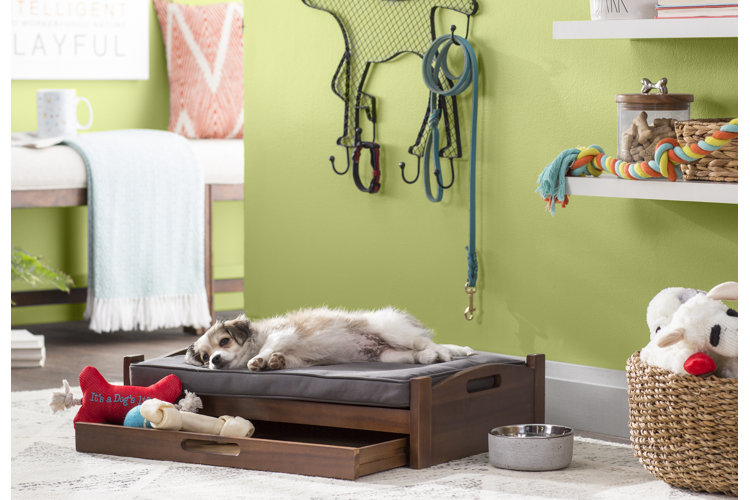When it comes to choosing a dog bed for your furry friend, size matters. As a responsible pet owner, you may wonder if a dog bed should be bigger than your pup. In this article, we will explore the importance of selecting the right size dog bed to provide comfort, support, and a cozy sanctuary for your beloved canine companion. Discover the key factors to consider in order to ensure your dog’s bed is the perfect fit, catering to their size, breed, and sleeping habits.
Factors to Consider
When it comes to choosing the right dog bed, there are several factors that you should take into consideration. These factors include the breed size of your dog, their sleeping habits, growth stage, weight and body length, as well as their orthopedic needs. By considering these factors carefully, you can ensure that you select a dog bed that will provide your furry friend with the ultimate comfort and support.
Breed Size
The size of your dog is an important factor to consider when choosing a dog bed. Different breeds have different size requirements, so it’s essential to select a bed that is appropriate for your pet. Here are the main categories of breed sizes and the considerations to keep in mind:
Small Breeds
Small breeds, such as Chihuahuas and Yorkshire Terriers, require beds that are specifically designed to accommodate their petite frames. Look for beds that offer adequate support and are the perfect size for your small pup to curl up in comfortably.
Medium Breeds
Medium-sized breeds, like Beagles and Cocker Spaniels, will benefit from a dog bed that provides enough space for them to stretch out and relax. Opt for a bed that is both spacious and supportive, ensuring your dog can find the perfect position for a good night’s sleep.
Large Breeds
For large breeds like German Shepherds and Labradors, a larger bed with ample room to spread out is essential. These breeds often enjoy stretching out while they sleep, so a bed with enough space is crucial to their comfort and well-being.
Extra Large Breeds
Giant breeds, including Great Danes and Saint Bernards, require extra large beds to accommodate their size. These dogs need plenty of space to lie down comfortably without feeling cramped or restricted. Choosing a bed that is specifically designed for extra-large breeds will ensure your furry friend can rest peacefully.
Sleeping Habits
Understanding your dog’s sleeping habits is another crucial factor to consider when selecting the right dog bed. Here are some common sleeping habits to think about:
Curling Up
Many dogs, particularly small breeds, have a tendency to curl up when they sleep. If your dog loves to curl into a ball, look for a bed with raised sides or bolsters that can provide a sense of security and coziness.
Stretching Out
Some dogs prefer to stretch out when they sleep, especially larger breeds. If your furry friend enjoys sprawling out, choose a bed that offers ample space and has a flat surface for them to lie on comfortably.
Preference for Cozy Spaces
Many dogs enjoy the feeling of being nestled in a cozy space. Look for beds that have a cozy, enclosed design, such as hooded beds or cave-style beds. These options provide a sense of security and privacy that many dogs appreciate.
Burrowing
Certain breeds, like Dachshunds and Terriers, have a natural instinct to burrow. If your dog enjoys burrowing under blankets or pillows, consider getting them a bed with a removable cover that they can easily burrow into for extra comfort.
Growth Stage
Your dog’s growth stage is another important consideration when choosing a dog bed. Different stages of life require different levels of comfort and support. Take into account the following growth stages:
Puppy Stage
During the puppy stage, it is important to choose a bed that allows for growth. Look for beds that are suitable for their current size but have enough space to accommodate their future growth. Alternatively, you may opt for an adjustable bed that can be resized as your puppy grows.
Adult Stage
In the adult stage, dogs have usually reached their full size and have established their sleeping habits. Pay attention to their preferences, whether they like to stretch out or curl up, and choose a bed that meets their needs accordingly.
Senior Stage
As dogs age, their joints can become stiff and they may develop arthritis or hip dysplasia. It is crucial to provide them with a bed that offers excellent support and cushioning to relieve any discomfort. Orthopedic beds with memory foam or therapeutic gel are ideal for senior dogs.
Weight and Body Length
Considering your dog’s weight and body length is essential when selecting the right size of the bed. Here are some aspects to keep in mind:
Weight
Make sure to choose a bed that can comfortably support your dog’s weight. Look for beds with weight capacities that exceed your dog’s weight to ensure that they can rest without putting unnecessary strain on the bed’s structure.
Body Length
The length of your dog’s body is another important consideration. Measure your dog from the tip of their nose to the base of their tail, and choose a bed that is at least a few inches longer. This will ensure that your dog can fully stretch out without hanging off the edge of the bed.
Orthopedic Needs
If your dog has orthopedic needs, it’s crucial to choose a bed that provides the necessary support and comfort. Here are some considerations to keep in mind:
Joint Support
Dogs with joint issues or arthritis benefit greatly from beds with orthopedic features. Look for beds that have memory foam or gel inserts that conform to your dog’s body, providing optimal support and relieving pressure on their joints.
Extra Cushioning
Some dogs simply prefer extra cushioning for their comfort. Beds with thick padding or multiple layers of foam can provide the extra support and plushness that these dogs prefer.
Arthritis or Hip Dysplasia
If your dog suffers from arthritis or hip dysplasia, look for beds specifically designed for these conditions. Orthopedic beds often have special features like heat therapy or cooling gel to alleviate discomfort and promote better sleep.
Choosing the Right Size
To choose the right size dog bed, you will need to take accurate measurements of your dog and consider any additional factors if you have multiple dogs. Here are some guidelines to help you with this process:
Measurements
Measure your dog’s length, width, and height while they are in a relaxed and stretched-out position. Add some extra inches to each measurement to ensure that your dog has ample space to move comfortably. This will help you determine the correct bed size for your furry friend.
Considerations for Multiple Dogs
If you have multiple dogs, it’s essential to consider their size compatibility and how they like to sleep. Some dogs may enjoy sharing a bed, while others prefer having their own space. Take into account each dog’s breed size, sleeping habits, and personal preferences to ensure that you choose beds that accommodate them all.
Ensuring Comfort and Safety
Apart from the size and fit, there are several other factors that can contribute to your dog’s overall comfort and safety. When shopping for a dog bed, keep the following aspects in mind:
Ample Space
Make sure your chosen dog bed provides enough space for your dog to move around comfortably. A bed that is too small can cause discomfort and restrict your dog’s movements, leading to poor sleep quality.
Supportive Structure
A dog bed with a supportive structure is crucial for your pet’s physical well-being. Look for beds with sturdy frames or solid construction that can withstand your dog’s weight and provide long-lasting support.
Easy to Clean
Keeping your dog’s bed clean is important for their hygiene and health. Choose a bed with a removable cover that is machine washable or easy to wipe clean, so you can keep it fresh and free from dirt, hair, and odors.
Quality Materials
High-quality materials ensure durability and comfort for your dog. Look for beds made from sturdy and non-toxic materials that are safe for your dog to use. Beds with hypoallergenic or water-resistant properties can also be beneficial.
Safety Features
Certain safety features can provide peace of mind for both you and your dog. Look for beds with non-slip bottoms to prevent sliding, as well as non-toxic and flame-resistant materials. Additionally, check that there are no small parts or choking hazards that could harm your dog.
By considering all these factors when choosing a dog bed, you can ensure that your furry friend will have a comfortable and safe place to rest. Remember to take into account your dog’s specific needs, preferences, and any orthopedic requirements they may have. By providing them with the perfect bed, you are not only enhancing their sleep quality but also contributing to their overall well-being and happiness. Happy shopping, and may your dog enjoy many peaceful and cozy nights in their new bed!









